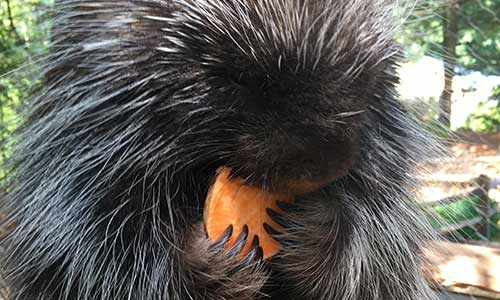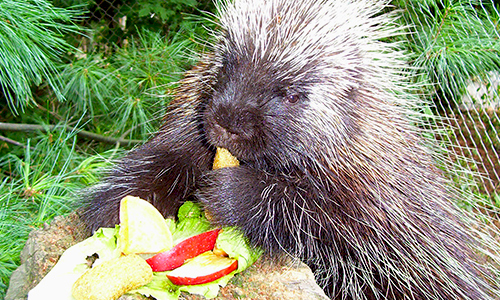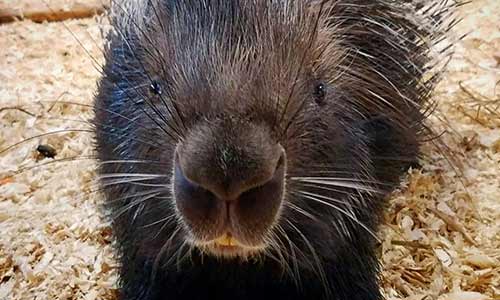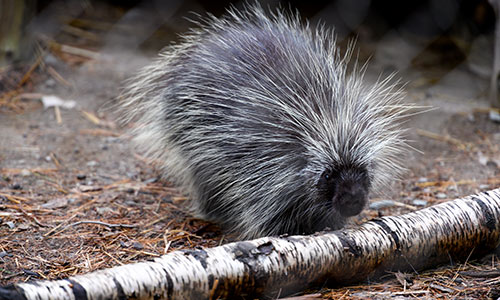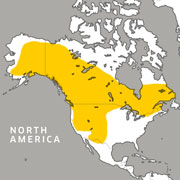Appearance:
Porcupines have thick underfur covered with long, wiry guard hairs on the front half of their body. They have up to 30,000 shorter, heavier quills on their back, sides, legs and tail. They may have yellowish quills and yellow-tipped guard hairs, or white quills and white-tipped guard hairs. Their quills are hollow which provide buoyancy while swimming.
Due to long, curved claws, they have a pigeon-toed walk while on the ground. Their broad feet and sharp claws also help them dig for roots and for shelter. Like the beaver, the North American porcupine has bright orange incisors.
Size:
- Weight: Up to 30 pounds
- Length: 2 to 3 feet
Diet:
Porcupines enjoy a seasonal diet, feeding on the inner bark of trees and evergreen needles during the winter. In the spring, they eat buds and in summer, roots, leaves, berries, fruits and seeds. In the fall, they eat fruits and nuts. They also gnaw on old bones and shed antlers for calcium and salt. They may eat up to a pound of plant material per day.
Reproduction:
North American porcupines mate in the late summer/early fall. They conduct an elaborate courtship involving a dance and extensive vocalizations. The male porcupine will often shower the female with urine before mating.
After about a 7-month gestation, a single offspring (a porcupette) is born in the spring. The porcupette‘s quills are soft upon birth but will quickly harden. At about two to three weeks, offspring are capable of feeding on plant material. About six months after birth, they're weaned and will leave the mother. Maturity is reached by 2 to 2.5 years of age.
Behavior:
Porcupines are mainly nocturnal, but they may be seen during the day, especially in the tops of trees. They climb awkwardly, but they’re more at home in trees than on the ground. Generally, porcupines are solitary in the summer and colonial in winter, living in dens found in hollow trees or natural caves in rocks. Porcupines do not hibernate.
They communicate with grunts and high-pitched cries that may be heard for a quarter of a mile, especially in the fall rutting season. Acute hearing allows them to respond quickly to threats.
Porcupines are more likely to flee, but when threatened, they'll rattle their quills to ward off predators. It's a common misconception that porcupines are able to "shoot" their quills. In fact, they shed them upon impact, so that the quills become imbedded in an attacker.
Porcupine quills have a greasy coating that contains antibiotics, possibly to protect the porcupine from infection if it's accidentally pricked by its own quills. Quills also provide buoyancy while swimming.
Habitat/Range:
North American porcupines are native to the coniferous and mixed-forest habitats of Canada, the northeastern and western regions of the United States and northern Mexico. They're not found in southeastern United States and southeastern Mexico.
Median Life Expectancy:
10 years
Threats:
North American porcupines are a species of Least Concern. They are considered “pests” because they can damage ornamental plants, wooden buildings, tool handles and other wooden objects. They are in danger of extinction in Mexico because of hunting.
Fun Facts:
- A family of porcupines is called a prickle.
- The porcupine’s common name is derived from French and means “thorny hog,” referring to the animal's quills. The scientific name, Erethizon, is Greek for "arouse" and is a reference to the species' reputation for being irritable. Dorsatum, is Latin for back.
- The North American porcupine is one of the largest rodents found in North America, second to the North American beaver.

